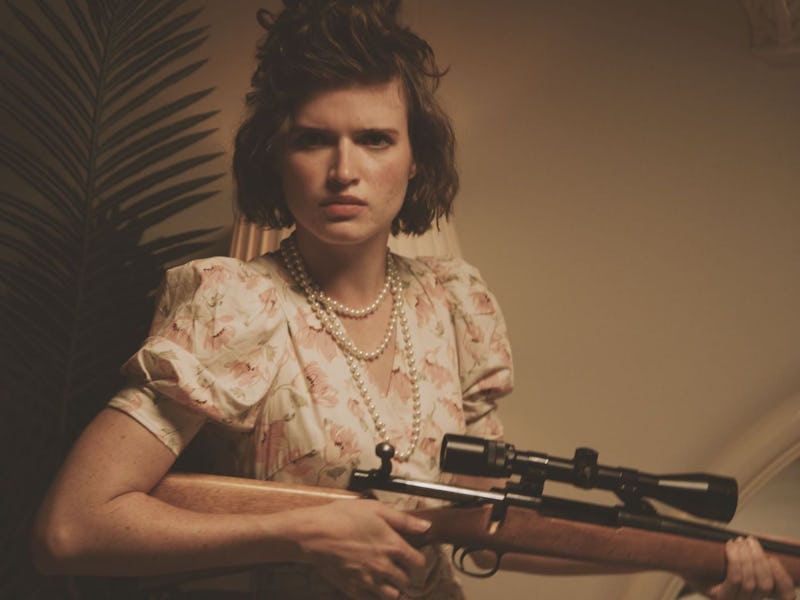The Scariest Anthology Series of the Century is in Top Form Once Again
V/H/S/85 is a terrifying return to form for the horror anthology.

There’s a certain irony that V/H/S, the 2010s-era found footage horror anthology series, has outlasted VHS, the 1980s-era home video format, in pop culture relevance. Your old VHS tapes command higher cash value, but nobody watches VHS anymore. They’re watching V/H/S, or its sequels, or maybe one of its two spinoffs.
To date, V/H/S/2 still reigns over this unexpected institution of modern horror. Partial credit for the coronation is owed to “Safe Haven,” Gareth Evans and Timo Tjahjanto’s sanity-shredding contribution; the film’s uniformity deserves the rest. Consistency distinguishes the best of the V/H/S pictures from the others, as with any omnibus production, and that makes the series’ 2023 edition, V/H/S/85, the prince to V/H/S/2’s king.
That’s no small feat. Even V/H/S/99 and V/H/S/94, which brought the property roaring back to horror’s consciousness after a semi-dormant period, both feature segments that vastly overshadow the others – V/H/S/94’s “The Subject” and V/H/S/99’s “To Hell and Back” – and dilute the holistic experience. V/H/S/85 achieves cohesion with a chaotic slurry of established directors and up-and-comers, smudged over an antiquated medium. Scott Derrickson’s name grabs instant attention, with V/H/S veteran David Bruckner coming in a close second. They’re joined by Mike P. Nelson, Natasha Kermani, and Gigi Saul Guerrero, gifted filmmakers each a project or two away from making a splash in horror’s rising tides.
The concept is simple. It’s the Great Format War of the mid-1980s, when VHS waged a campaign for consumer-level supremacy against Betamax. Bruckner stages his segment, “Total Copy,” as a “taped-off-TV” documentary about a strange creature under study by wildly incautious scientists; the short functions as the bedrock for the rest, like a home video mixtape. Nelson’s two-parter, “No Wake / Ambrosia” follows a group of young adults on a camping trick that defies horror stereotypes through several twists and turns. A performance artist’s scathing critique of deified technology accidentally awakens a metaverse-dwelling demon in Kermani’s “TKNOGD.” A weary detective investigates a trio of grisly murders captured on tapes from the future in Derrickson’s “Dreamkill.” And in a macabre bit of kismet, the arbitrarily chosen year meets with real-life cataclysm in Guerrero’s “God of Death.”
V/H/S/85 is the best entry in the V/H/S series since V/H/S/2.
V/H/S/85 wisely maintains the pass on unifying mythology started with 2014’s V/H/S: Viral. There’s no eldritch reason for these tapes to be bundled together. They just are. It’s a disturbing time capsule, a more effectively frightening approach than the implications of existential consequence. It’s elegant, too, insofar as construction is an oft-overlooked factor in found-footage horror, anthology or not. If you grew up in the 1980s, you might know a thing or two about recording over precious family footage by accident. Tapping into one of the period’s common techno-oopsies drums up a sense of familiarity that works in V/H/S/85’s favor, and also allays any questions about whose shelf the tape was pulled from. When all’s said and done, you won’t want to know. Every single segment here unnerves viewers to different extents and through a variety pack of horror sensibilities: cult, disaster, supernatural, alien.
The director quintet plays off of audience nostalgia through presentation. VHS was a simple format. The 1980s were simple times. “Simple” is relative, of course — contemporary technology has a way of dangerously oversimplifying things, after all — but in each of V/H/S/85’s segments, the straightforwardness of VHS formatting lulls characters into a false sense of security. Filming themselves and their actions gives them the illusion of control when control is entirely out of their hands.
“God of Death” is the standout short in V/H/S/85, but Guerrero’s peers are all showing their best work too.
Ada (Anna Hashizume), for instance, the doomed multimedia spoken word poet in “TKNOGD,” despises virtual reality but uses it in her act, assured that she’s in charge over the tech. Meanwhile, Ruth (Evie Bair) exhales self-confidence in her own auteurial power in “Ambrosia.” When V/H/S/85 pulls focus away from this theme, it’s for other meaningful reasons, like in “God of Death,” where Guerrero, using a real VHS camera, plants her viewers in media res during an overwhelming and terrifying tragedy whose lasting effects remain in plain sight in Mexico City even today. Hers is the best of the lot, achieving fearsome immediacy in contrast to the retro setting while leaving her personal stamp as an artist on the project writ large at the same time.
Good as “God of Death” is, though, Guerrero’s peers are all operating at their highest capacity, sparking vital energy in V/H/S/85 from start to finish. It’s surprisingly urgent for a production rooted so firmly in the past. With found footage moving away from analog to digital in movies like Deadstream, Host, Unfriended, and Open Windows, that’s as great an accomplishment as consistency itself.